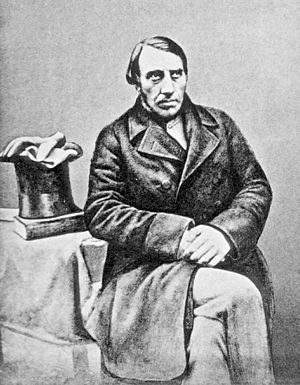John Goodsir facts for kids
Quick facts for kids
John Goodsir
FRS FRSE FRCSE
|
|
|---|---|
 |
|
| Born | 20 March 1814 Anstruther, Fife, Scotland
|
| Died | 6 March 1867 (aged 52) Edinburgh, Midlothian, Scotland
|
| Education | |
| Occupation | Anatomist, curator |
| Relatives |
|
John Goodsir (born March 20, 1814 – died March 6, 1867) was a Scottish anatomist. He was a very important scientist who helped create the idea of cell theory. This theory explains that all living things are made of tiny units called cells.
Contents
Early Life and Education
John Goodsir was born in Anstruther, Fife, Scotland. His father was a doctor. John was one of several brothers. His younger brother, Harry Goodsir, was also a scientist who sadly disappeared during the Franklin expedition to the Arctic. Another brother, Robert, also became a doctor and searched for Harry.
When John was 12, he started studying at the University of St Andrews. A year later, he began training to be a surgeon and dentist in Edinburgh. This training allowed him to attend classes at the Edinburgh University Medical School. He finished his training in 1833 and became a qualified surgeon in 1835.
After his training, he went back to his hometown to work with his father. There, he continued his favorite hobby: exploring the coast and collecting all sorts of wildlife. These specimens later became part of a museum collection.
In Edinburgh, John became good friends with other scientists and artists. They called themselves the Brotherhood of the Friends of Truth. Their flat became a popular meeting place for discussions.
Early Scientific Discoveries
During his training, Goodsir started studying human teeth. He made an important discovery: baby teeth (deciduous teeth) do not just turn into permanent teeth. Instead, permanent teeth grow separately. He published a paper about this in 1839.
He also started using microscopes. A professor named Robert Jameson lent him a special microscope. This encouraged Goodsir to study tiny structures, which helped him understand cells and tissues much better. He joined a science group called the Wernerian Natural History Society.
One of his teachers, Robert Knox, taught him how important it was to compare the bodies of different animals. This helped Goodsir understand how life works and how diseases affect the body.
Museum Work and Teaching

In 1841, Goodsir became the conservator (or caretaker) of the museum at the Royal College of Surgeons of Edinburgh. He made the museum popular by giving public talks about its collections. He also taught medical students. In his lectures, he shared his new ideas about cell theory. These ideas were later used and developed by a famous German scientist named Rudolf Virchow.
Goodsir was also the first to describe a type of bacteria found in the stomach, called Sarcina ventriculi. This showed how good he was at observing tiny things and thinking in new ways.
In 1843, he became the curator of the University of Edinburgh's natural history collection. His brother Harry took over his old job at the Royal College of Surgeons museum. In 1844, Goodsir started teaching anatomy at the University of Edinburgh. His classes were very popular and helped improve the university's reputation for teaching anatomy.
In 1845, he published a book with his brother Harry called Anatomical and Pathological Observations. This book shared his ideas about cell structure and how cells work. It helped him become known around the world. Goodsir also made the anatomy department better by improving the dissection rooms and hiring more staff. His team was among the first to use advanced microscopes.
Developing Cell Theory
Goodsir used his advanced microscopes to study cells very closely. He developed his own ideas about how cells are structured and how they work. He believed that all living things are made of these tiny units called cells. Other scientists like Matthias Jakob Schleiden and Theodor Schwann also worked on cell theory.
Goodsir asked important questions like: "What is a cell made of?" and "How do cells form and multiply?" His ideas were very original. Another famous scientist, Rudolf Virchow, praised Goodsir's work greatly. Virchow even dedicated his famous book, Cellular Pathology, to Goodsir. He called Goodsir "one of the earliest and most acute observers of cell-life."
Because of his important work, Goodsir was elected to the Royal Society of Edinburgh in 1842. He also became a member of the Royal Society in 1846 and the American Philosophical Society in 1849.
Professor of Anatomy
In 1846, John Goodsir became the Professor of Anatomy at the University of Edinburgh. He made many improvements to how anatomy was taught. Because of his excellent teaching, the number of students in his anatomy classes grew a lot. By 1860, there were 354 students!
Later Years
From 1850, Goodsir started to become unwell with a long-term illness. Even though he was sick, he continued to work. After his friend Edward Forbes died in 1854, Goodsir even took over Forbes's lectures in addition to his own.
John Goodsir passed away on March 6, 1867, at the age of 52. He is buried in Dean Cemetery in Edinburgh, next to his friend Edward Forbes.

